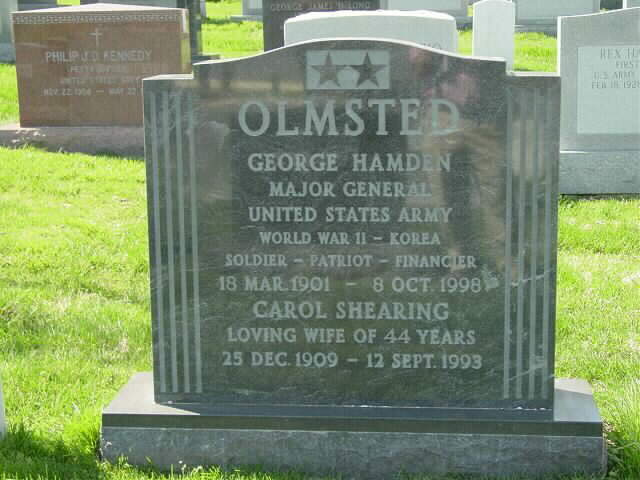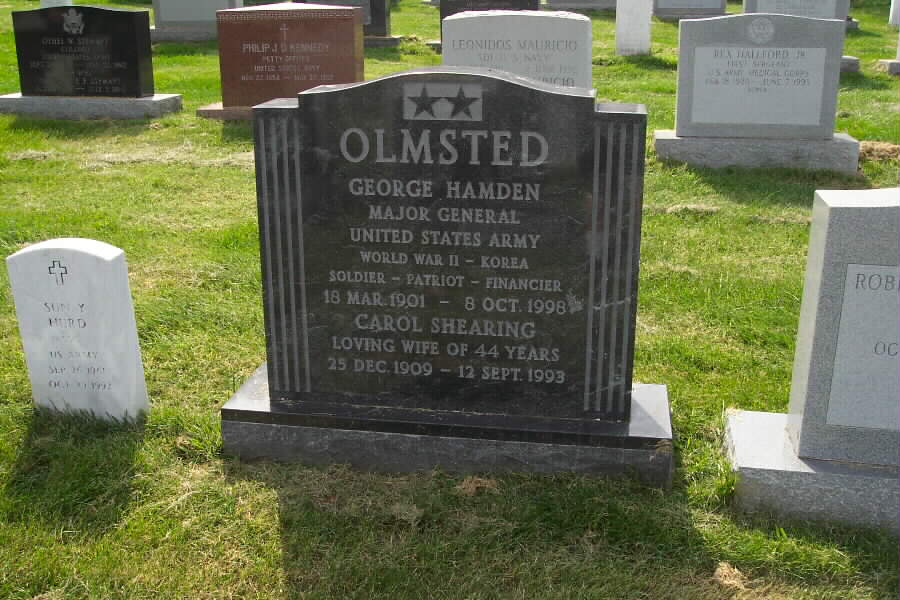From a contemporary press report:
George H. Olmsted, 97, a retired Army General who became one of the Washington area’s wealthiest and most powerful businessmen, died October 8, 1998 of cerebral vascular disease at his home in North Arlington, Virginia.
General Olmsted was a U.S. Military Academy graduate who retired three times from the Army but was recalled for service in World War II and the Korean War.
Outside the service, he entered the insurance business in the 1920s in Iowa and eventually became head of International Bank, a major financial services empire based in Washington. International Bank, which called itself “America’s leading merchant bank,” was not a bank in the usual sense. Instead, according to a 1980 news account, it was a corporate holding company patterned on the merchant banks of Europe, which invest funds in many businesses. It was acquired in the 1980s by Uslico, an insurance holding company that it had once owned in part. Later, Uslico was acquired by another business.
General Olmsted was modest about his business achievements, asserting that the success of his enterprises was a matter of “finding competent management, giving them a free rein and then supporting them through thick and thin.” The credit, he said, “belongs to the men who conduct the operations. I have sense enough not to interfere with them.”
However, observers of General Olmsted’s career noted that he was enterprising even during his military career. His effort to rescue 30,000 prisoners of war held by the Japanese in camps throughout Asia at the end of World War II was of particular note.
As General Olmsted later told the story, shortly before the Japanese surrender, the military got word that a Japanese collapse was imminent and that the prisoners had to be rescued immediately to save them from possible harm. “We didn’t have the troops to send in,” General Olmsted said. “If we had, we didn’t have the planes to carry them or the means of supplying them.” When he laid out his rescue scheme to his superior, General Albert C. Wedemeyer, Wedemeyer responded: “That’s the craziest scheme I have ever heard in the Army. Try it. If it fails, remember we are readying court-martial charges against you.”
General Olmsted first ordered leaflets dropped. Then he sent a single airplane carrying six unarmed men to parachute into each camp with a letter to the camp commander, signed by Wedemeyer. It said the Allies knew the number of prisoners in each camp and would hold the camp commander responsible if harm came to any prisoner. “It worked,” he said later. “But I had some sleepless days and nights.”
General Olmsted was born in Des Moines, Iowa, attended Iowa State University briefly and graduated from West Point in 1922 as first captain of the Corps of Cadets. He ranked second in his class academically and had been its president for three years. He was also the second-string quarterback of the 1922 football team and was featherweight boxing champion at West Point.
He left the Army in 1923 as a lieutenant to go into business with his father, who was running a small insurance agency. He started his own firm in 1924, and by 1928 he began the pattern that distinguished his later career: He acquired another company, in this case Travelers Mutual Casualty Co. of Des Moines. Several other acquisitions followed before he was recalled to active duty in the Army shortly after the outbreak of World War II. At the end of the war, he worked out a huge sale of military equipment left behind in China. President Harry S. Truman was said to have described his effort as “the best liquidation of surplus U.S. equipment anywhere in the world.”
His World War II service was recognized with the Distinguished Service Medal, the Legion of Merit and the Bronze Star. Britain, France and China also awarded him medals.
After the war, he returned to Iowa and his businesses. He also made an unsuccessful attempt to win the Republican nomination for governor in 1947.
When fighting broke out in Korea in 1950, he was recalled to the service, heading the Army’s military assistance operations, and was promoted to major general. He was sent to the Pentagon to take charge of all U.S. military assistance.
On his release from active duty in 1953, he again returned to his business career, spending much of his time in Washington. The first big acquisition after his return to private life came in 1953, when he headed a group that successfully bid for control of United Services Life Insurance Co. International Bank followed. He was honored for his support of education, the Boy Scouts and the effort to open a bank here owned by American Indian tribes. A landmark Arlington tower was named for him.
His first wife, Virginia Camp, died in 1944. His wife, Carol Shearing Olmsted, died five years ago. Survivors include three children, Alice Olmsted Burt of Ormond Beach, Fla., George H. Olmsted Jr. of Hendersonville, N.C., and Jerauld L. Olmsted of Bethesda; eight grandchildren.
Buried in Arlington National Cemetery on Monday, 26 October 1998.
Michael Robert Patterson was born in Arlington and is the son of a former officer of the US Army. So it was no wonder that sooner or later his interests drew him to American history and especially to American military history. Many of his articles can be found on renowned portals like the New York Times, Washingtonpost or Wikipedia.
Reviewed by: Michael Howard


